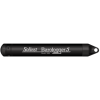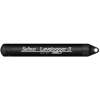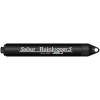Solinst Levelogger 5 LTC Water Level & Conductivity Loggers
Features
- Increased memory for logging up to 100,000 sets of data
- Upgraded platinum RTD and conductivity sensor for better sensitivity
- Double O-ring seals with 2x over pressurization rating
- Free ground shipping
- Expedited repair and warranty service
- Lifetime technical support
- More
Overview
The Solinst Levelogger 5 LTC combines a datalogger, 8-year battery, Hastelloy pressure sensor, temperature detector, and conductivity sensor within a small waterproof housing, 22mm x 208mm (7/8" x 8.2"). A baked-on coating using polymerization technology protects the body against corrosion, abrasion and high temperatures. The conductivity sensor is a 4-electrode platinum sensor with autoranging capabilities. The minimal-maintenance, sealed Levelogger 5 LTC is simple to clean and calibrate, even in the field.
Level Sensor: Piezoresistive Silicon with Hastelloy Sensor
Ranges: 5, 10, 20, 30, 100, and 200 m
Accuracy: ±0.05% FS
Resolution: 0.001% FS to 0.0006% FS
Units of Measure: cm, m, ft, psi, kPa, bar (ºC, ºF)
Normalization: Automatic Temperature Compensation
Temp Comp. Range: 0ºC to 50ºC
Temperature Sensor: Platinum Resistance Temperature Detector (RTD)
Accuracy: ±0.05ºC
Resolution: 0.003ºC
Conductivity Sensor: 4-Electrode Platinum
Full Range: 0 – 100,000 µS/cm
Calibrated Range: 50 – 80,000 µS/cm
Accuracy: ±1%: 5,000 µS/cm – 80,000 µS/cm; greater of ±2% or 15 µS/cm: 50 µS/cm –5,000 µS/cm
Resolution: ±0.1 µS/cm
Temp Comp. Range: 0ºC – 50ºC
Normalization: Specific Conductance @ 25˚C
Battery Life: 8 Years (1 reading every 5 minutes)
Clock Accuracy (typical): ±1 minute/year (-20ºC to 80ºC)
Operating Temperature: -20ºC to 80ºC
Maximum Readings: 100,000 sets of readings
Memory: Slate or Continuous
Communication: Optical high-speed: 57,600 bps with USB
Size: 22 mm x 208 mm (7/8" x 8.2")
Weight: 197 grams (6.95 oz)
Corrosion Resistance: Baked-on coating using polymerization
Wetted Materials: Platinum, Delrin®, Viton®, 316L Stainless Steel, Hastelloy, Regulator approved PFAS-free PTFE
(inside and out)
Sampling Mode: Linear, Event & User-Selectable with Repeat Mode, Future Start, Future Stop, Real-Time View
Measurement Rates: 2 seconds to 99 hours
Barometric Compensation: Software Wizard and Barologger 5
In The News
From Paddles to Phytoplankton: Studying Vermont’s Wildest Lakes
For six months of the year, Rachel Cray, a third-year PhD student at the Vermont Limnology Laboratory at the University of Vermont, lives between a microscope and her laptop, running data. For the other six months, she is hiking and canoeing four of Vermont’s lakes, collecting bi-weekly water samples. Cray studies algal phenology across four lakes in Vermont, US, that have low anthropogenic stress—or in other words, are very remote. Funded by the National Science Foundation Career Award to Dr. Mindy Morales, the lakes Cray researches part of the Vermont Sentinel Lakes Program, which studies 13 lakes in the area and, in turn, feeds into the Regional Monitoring Network, which operates in the Northeast and Midwest US.
Read MoreReimagining Water Filtration: How Monitoring and Science Enhance FloWater Filtration Systems
Over 50% of Americans think their tap water is unsafe , according to the Environmental Working Group (EWG). Other recent surveys have found that number to be as high as 70% of persons surveyed. Whether due to increased public awareness of water quality issues or confusion about how municipal water sources are regulated, there is a clear distrust of tap water in the United States. According to industry expert Rich Razgaitis, CEO and co-founder of the water purification company FloWater, this issue creates a damaging cycle. Razgaitis explained that the health and environmental problems associated with contaminated water aren’t the only issues. As people become increasingly aware that some tap water is unsafe, they resort to bottled water.
Read MoreMonitoring New Hampshire’s Aquatic Ecosystems: Continuous Data Collection in the Lamprey River Watershed
New Hampshire’s aquatic ecosystems provide a range of ecosystem services to the state and region. Resources and services like clean water, carbon storage, climate regulation, nutrient regulation, and opportunities for recreation all depend on New Hampshire’s aquatic ecosystems remaining healthy. Jody Potter, an analytical instrumentation scientist at the University of New Hampshire (UNH), is studying these aquatic ecosystems in hopes of developing an improved understanding of ecosystem services and their interactions with climate change, climate variability, and land use changes. [caption id="attachment_39799" align="alignnone" width="940"] Aquatic sensors in the Merrimack River in Bedford, NH, with I-293 in the background.
Read More



































































